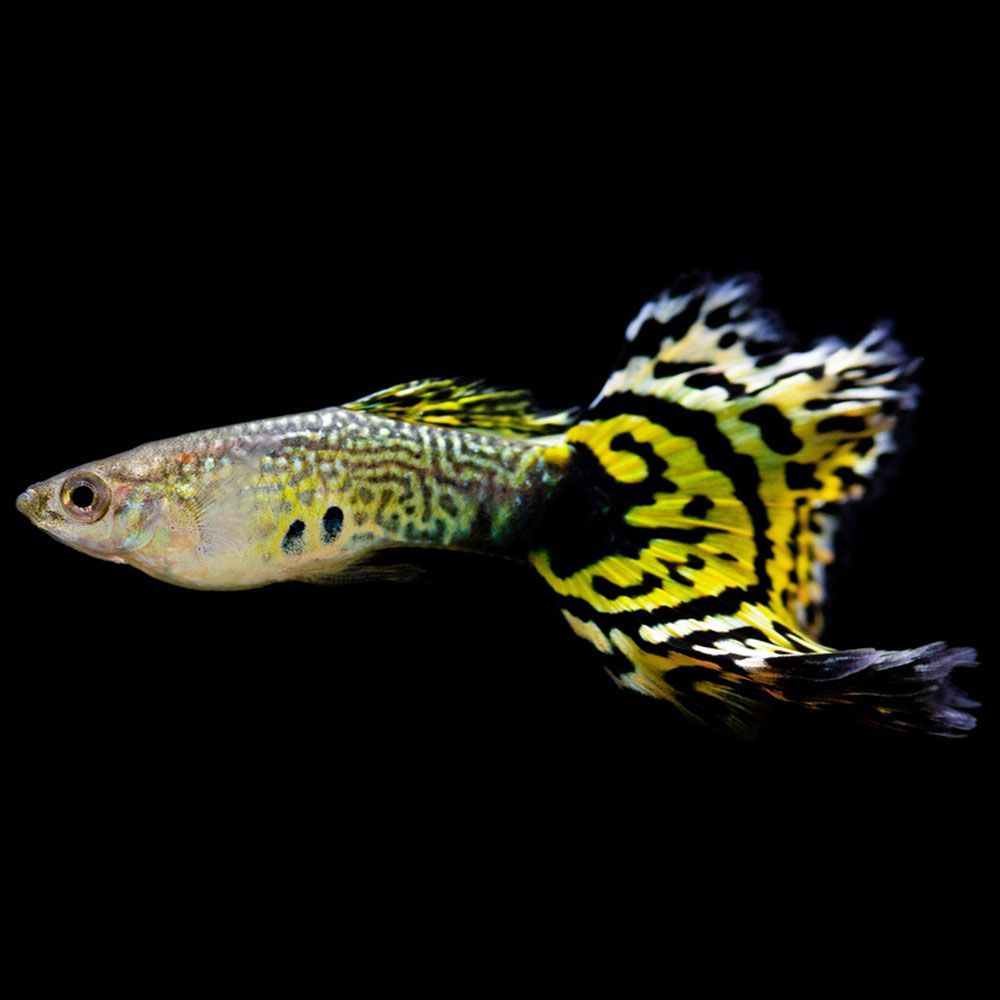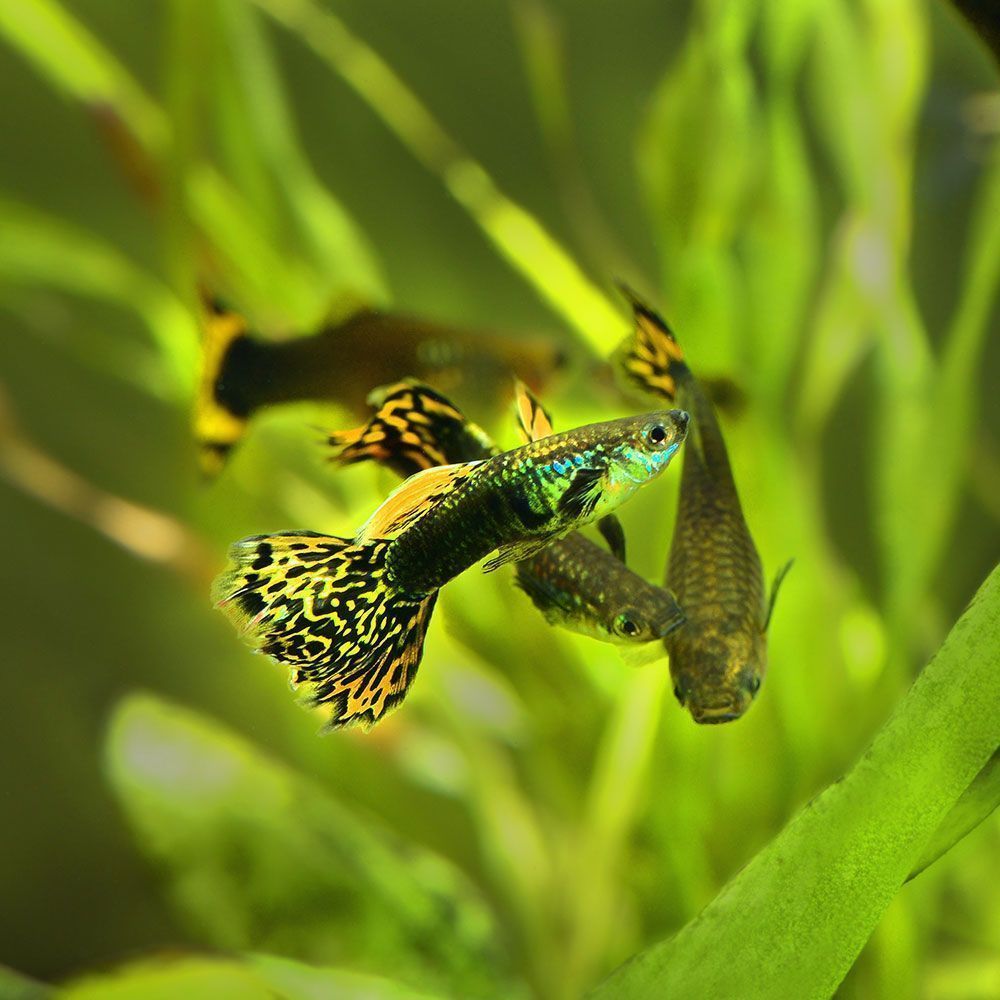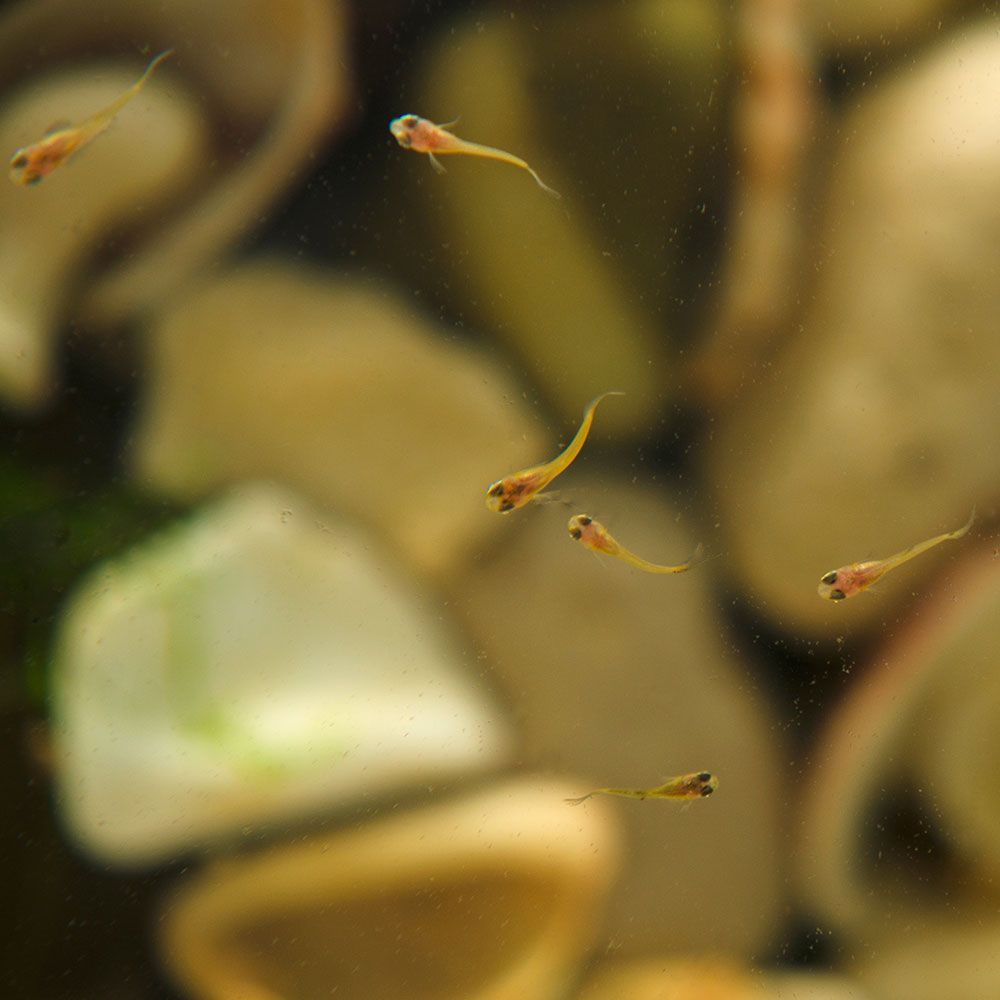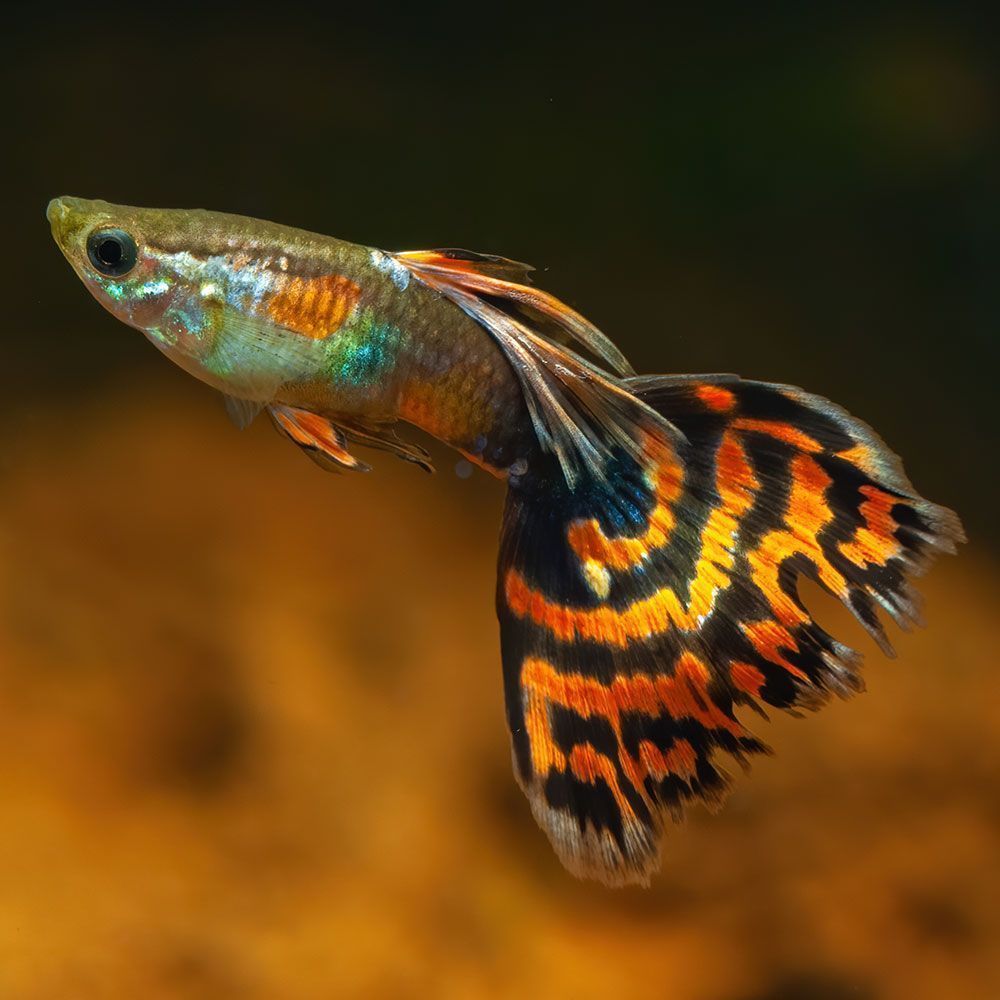If you are looking for a small yet majestic addition to your freshwater tank, get yourself a handful of guppy fish.
It is peaceful and also easy to care for, making it an ideal pick for both beginner and professional aquarists alike. The species is highly active, and so it is a delight to watch them zipping around the tank.
Intrigued to know more about this captivating species, let’s dive right in.
What is Guppy Fish?
Guppy is a freshwater fish which belongs to the Poeciliidae family, has a unique tail and is popular among beginner and experienced aquarium owners all over the world.
| Origin | South America, Antigua and Barbuda, Barbados, Suriname, Guyana, Trinidad and Tobago, Venezuela, French Guiana. |
| Order | Cyprinodontiformes |
| Family | Poeciliidae |
| Scientific Name | Poecilia reticulata |
| Common Names | Rainbow fish, million fish, guppy, Barbados millions |
| IUCN Red List Status | Least Concern |
| Appearance | Elongated body, teeth on both jaws, dull gray color in the wild, males have spots, stripes, or colorful markings Captivity-bred strains have various tones, marks, and tail fin types |
| Size | Up to 5 cm (2 in) on average; Females: up to 6 cm (2.4 in); Male: up to 4 cm (1.6 in) |
| Lifespan | 2-5 years with best care |
| Temperament | Peaceful, non-territorial, aggression during meals and in cramped space |
| Tank Level | Middle to top dwellers |
| Water Temperature | 64-75 °F (18-23 °C) |
| pH Level | 7-8 |
| Water Hardness | 6-15 dGH |
| Care Level | Very Easy |
| Minimum Tank Size | 10 gallons for three same-gendered fish, 20 gallons for mixed |
| Tank Environment | Planted tank with caves, rocks, driftwood and lots of swimming space |
| Diet | Omnivorous with carnivorous preferences |
| Tank Mates | Own group, peaceful, similar-sized species |
What is the Natural Habitat of Guppy Fish?
Guppy fish is native to Antigua and Barbuda, Barbados, Suriname, Guyana, Trinidad and Tobago, French Guiana and Venezuela of South America.
It is found in various water bodies, including the Natal and Guayre rivers, Lake Kuruman Eye, and Lake Otjikoto.
The fish is also abundant in ponds, canals, and ditches at low elevations to mountain streams at high elevations.
This freshwater fish can also tolerate brackish water. It stays near the bottom of the water column (benthopelagic) and often swims in groups to protect itself from predators.
It has been introduced to many different countries on all continents (except Antarctica) as a means of mosquito control. In many cases, the fish has negatively impacted native fish populations, i.e., turned invasive.
Guppies have been listed as Least Concern in the IUCN Red List of Threatened Species in 2020.
Which family does Guppy Fish belong?
The fish is a member of the Poeciliidae family in the Cyprinodontiformes order. Its scientific name is Poecilia reticulata. It is also known by several common names, such as guppy, million fish, rainbowfish, and Barbados millions.
In the Poecilia genus, P. reticulata is the only guppy fish. Other than that, there is one Endler’s livebearer (P. wingei), and the rest are all mollies.
Fun Fact: The fish can reproduce constantly and have a lot of babies at once (fecundity). This is colloquially known as “millions” or “millionfish” in Trinidad.
How do Guppy Fish Look?

Now, If you are curious about the appearance and behavior of the guppy fish, let’s discuss them in more detail.
What is the Size of Guppy Fish?
The guppy fish can reach up to 5 cm (2 inches) in length on average. Females can grow as long as around 6 cm (2.4 inches), while males typically stay under 3-4 cm (1.2-1.6 inches).
What is the Color of Guppy Fish?
The naturally available guppy fish has dull gray scales, but males may exhibit spots, stripes, or colorful markings.
However, through selective breeding, around three hundred unique strains have been developed.
These strains feature vibrant two-toned and three-toned combinations of red, orange, black, yellow, green, pink, purple, silver, blue, and more. There are metallic colors as well.
What are the Features of Guppy Fish?
Guppies sport an elongated body and teeth on both jaws. They have patterns like spots and stripes on their bodies, fins, and tails. These patterns can vary in size, color, and style, especially on their tails.
These come in diverse tail types. Common ones include fantails, flag tails, round tails, spire tails, and veil tails, each with unique lengths and shapes.
How is a male Guppy Fish different from a female?
The mature male guppy fish is smaller than the adult female. The male also has a more slender and streamlined body shape and ornamental caudal and dorsal fins that are absent in females.
As the male fish matures, its anal fin transforms into a gonopodium, which it uses for internal fertilization.
Females, on the other hand, have a more rounded anal fin and tend to be larger, rounder, and thicker-bodied.
How does Guppy Fish behave in an aquarium?
The guppy fish is sociable and gentle and enjoys being in groups. It’s swift and lively, frequently engaging in playful chases.
But it might exhibit dominance by bullying, particularly during feeding or in cramped tanks.
The fish typically favor the middle and upper areas of the tank. But it seeks shelter under caves or plants when it feels threatened. Occasionally, it may nip at the fins of tank mates.
Keep three females for each male to avoid getting injured within themselves.
What is the Lifespan of Guppy Fish?
On average, the guppy fish lives for 2-5 years in captivity with optimal care.
Author’s Note: Guppies are studied in scientific research for ecology, evolution, and behavior. This is because they have 23 pairs of chromosomes – the same as humans, including sex chromosomes.
How to take care of Guppy Fish?

If you’re excited about adding this fish to your aquarium, let’s explore how to provide it with proper care!
What is the Tank Size for Guppy Fish?
The guppy fish is an active swimmer, and a larger tank gives it more space to move around comfortably.
Some recommend keeping 3 in a 10-gallon tank. But that works only if your specimens are of the same gender.
But if the specimens are mixed, they’ll quickly reproduce and overgrow the tank. In my experience, it’s better to use a 20-gallon tank then.
What is the Water Chemistry for Guppy Fish?
The guppy fish is quite resilient, but it’s important to keep the water conditions stable to minimize the risk of disease and stress.
- pH Levels: 7-8
- Water Temperature: 18-28 °C (64-75 °F)
- Water Hardness: 6-15 dGH
- Ammonia: 0 ppm
- Nitrite: 0 ppm
- Nitrate: Below 25 ppm
What is the Tank Environment for Guppy Fish?
Next, you must create the right tank environment for your guppies’ well-being. Here’s your complete guide to achieving this goal.
Which Substrate to use for Guppy Fish?
You can use any substrate, but there is one catch:
The substrate particles should be larger than a guppy’s head or small enough to pass through its stomach without causing issues.
A mix of sand and large river stones is a suitable choice.
Or, add gravel for diversity and bacteria growth, sand for a smooth, fish-friendly environment, or bare-bottom for low maintenance. For live plants, use nutrient-rich, plant-specific soil.
Which Plants to use for Guppy Fish?
The guppies thrive in heavily planted tanks where they can hide and explore. Choose small-leaved, soft plants that provide shade and mimic their natural habitat.
Avoid plants with large and coarse leaves that can harm your guppies’ fins.
Here is a list of plants you can opt for your finny buddies:
- Java moss
- Flame moss
- Christmas moss
- Anacharis elodea densa
- Water sprite
- Water wisteria
- Water lettuce
- Vallisneria
- Java fern
- Trident fern
- Windelov fern
- Narrow leaf fern
- Philippine
- Anubias nana
- Anubias barteri
- Anubias wrinkle leaf
- Anubias congensis
- Anubias hastifolia
What type of Lighting to use for Guppy Fish?
Set up 12 hours of fluorescent or LED lighting. Try to replicate natural habitat conditions for these fish.
Do not put the tank in direct sunlight, as it can impact temperature and encourage algal growth.
Which Décor to use for Guppy Fish?
Avoid sharp or abrasive decor like sharp snags, stones, or rocks that can harm the delicate fins of this fish. Opt for smooth materials like rounded rocks, caves, and driftwood. Make sure you leave enough open swimming areas.
Which filter should be used for Guppy Fish?
Use a filter for clean water, an algae scrubber to keep it tidy, and an air stone for oxygenation. Remove chlorine with a dechlorinating chemical.
You can use an internal or external filter, but cover openings to prevent fish from getting sucked, especially, juveniles.
What is the Water Flow Rate for a Guppy Fish tank?
Guppies prefer calm waters because strong currents exhaust them. So, keep the water flow gentle.
Fish Care Tip: Don’t let the temperature reach 86 °F (31 °C).
What does Guppy Fish eat?
In the wild, guppies are omnivorous with carnivorous tendencies. It feasts on zooplankton, small insects, detritus, algal remains, plants, diatoms, invertebrates, fish eggs, and even its own fry.
It forages in groups and shares feasts. Here is the list of foods you can feed them for a balanced diet:
- Vinegar eels
- Tubifex worms
- Beef hearts
- Egg yolks
- Chicken breast
- Shelled peas
- Spirulina
- Lettuce
- Zucchini
- Bloodworms
- Micro worms
- Fruit flies
- Mosquito larvae
- Daphnia
- Earthworms
- Algae wafers
- High-quality fish flakes
Feed your guppies twice daily for two minutes. Chop the food into small pieces when feeding it. Since it has a tiny mouth, large food chunks may choke or cause blockages in its intestines.
What are the Tank Mates for Guppy Fish?
These thrive well in species-only tanks. They should always be housed in groups of at least three since they are schooling fish.
But being adaptable and peaceful, guppies can coexist with peaceful fish of similar size and invertebrates. Below are a few compatible tank mates for these fish:
- Cardinal tetras, neon tetras, bloodfin tetras, black neon tetras, ember tetras
- Cory catfish, phantom catfish, suckermouth catfish
- Endlers livebearers
- White cloud mountain minnows
- Dwarf crayfish
- Kuhli loaches, dwarf chain loaches, clown loaches
- Common mollies
- Vampire plecos, bushynose plecos
- Southern platyfish, red wagtail platies, mickey mouse platies
- Chili rasboras, galaxy rasboras, harlequin rasboras
- Cherry barbs
- Honey gouramis
- Peacock gudgeons
- Swordtail fish
- Neon rainbowfish
- Siamese algae eaters
- Zebra danios
- Freshwater angelfish
- Ram cichlids
- Discus fish
You can add following non-fish tank mates as well :
- Nerite snails
- Cherry shrimps
- Amano shrimps
- African dwarf frogs
Which Tank Mates to Avoid for Guppy Fish?
Avoid housing the following fish with these species
- Aggressive fish (e.g., Betta splendens, scalars, gouramis, and fugu): These fish may nip at the vibrant fins of male guppy fish.
- Large predatory fish: They may view the guppy as prey.
- Species with greater appetites: They may steal the guppy’s food or even try to eat them.
- Territorial middle/top dwellers: They may compete for space.
- Species with different water requirements: They can’t coexist in the same environment. Namely, some incompatible species are:
- Tiger barbs
- Bala sharks
- African cichlids
- Goldfish: They take up lots of space, may get in fights, and the risk of disease transmission to guppies
- Oscar fish
- Killifish
- Flowerhorn fish
What are the Common Diseases for Guppy Fish?
Guppies are hardy species, yet they can be susceptible to common freshwater diseases like ich, fin rot, and columnaris. Additionally, they may encounter other diseases, including those listed below.
| Disease Name | Causes | Symptoms | Treatment |
|---|---|---|---|
| Swollen Gills | High ammonia or nitrite levels in tank water. | Fish gasping at the water’s surface for air. Visible swelling and redness in the gill area. | Perform an immediate 50% water change. Stop daily feeding for a few days. Add nitrifying bacteria to aid in ammonia/nitrite conversion |
| Guppy Disease | Various unicellular parasites. | Breathing problems, gas, weight loss, diarrhea | Improve water conditions, medications if necessary. |
| Dropsy | Bacterial infection leading to fluid buildup. | Swollen body, pinecone-like scales, bulging eyes, lethargy. | Isolate, Epsom salt bath, clean water. |
| Swim Bladder Disorder | Various factors, including stress, overeating, low water temperature, injuries, shock, and infections. | Fish unable to maintain balance, floating upside down or sideways. Lethargy, clamped fins. | Address the underlying cause of stress. Test and maintain low ammonia levels in the aquarium. Maintain the tank temperature at 78-80°F (25-27°C). |
| Velvet (Oodinium) | Parasitic disease caused by the protozoan Oodinium. | Tiny gold dust-like dots on fish’s skin and gills. Fish may rub against objects and show a loss of appetite. | Diminish light in the tank and perform frequent water changes. Use copper-based medications. Isolate and treat affected fish in a separate tank. |
| Red Blood Spot | Ammonia poisoning due to uncycled aquariums. | Small red spots or streaks on the fish’s body. Gasping for air, clamped fins. | Properly cycle and maintain the aquarium to prevent ammonia spikes. |
| Pop Eyes | Various factors, including injury, poor water quality, and infections. | Bulging or popped eyes. | Isolate the fish and consult a vet. |
| Gill Flukes | Infestation by tiny white worms. | Labored breathing, tightened fins, mucus, blood spots. | Quarantine affected fish, and prescribed medication |
| Fish Tuberculosis | Bacterial infection. | Hollow belly, tail, and fin rot, loss of appetite, bent spine. | Quarantine affected fish, give antibiotics, and euthanasia if there is no improvement. |
| Scoliosis (Bent Spine) | Genetic or environmental factors. | Bent spine, difficulty swimming. | Maintain good tank conditions and a healthy diet. |
Quick Tip: Perform regular 25% water changes every 1-2 weeks to maintain stable conditions and remove toxins.
How to Breed Guppy Fish?

Breeding guppies in aquariums is easy-peasy and often occurs spontaneously. But to get the most out of it, follow these steps…
Breeding Tank Preparation & Fish Conditioning
To optimize mating conditions for this fish, you should prepare a 30-gallon tank and maintain pristine water quality.
Ensure the water temperature is around 75-82°F (24-28°C). You can maintain the remaining water parameters like the main tank. Offer lots of plants and decor as hiding places and install a gentle filtration system.
Maintain a ratio of 1 male to 3-4 females to prevent excessive harassment of females by males. Feed high-protein carnivorous feed to condition the fish.
What is the Mating Ritual for Guppy Fish?
The male fish flares his fins and dances to attract the female. If she’s receptive, the male fertilizes her eggs using a specialized fin called a gonopodium. This process is quick and may be repeated multiple times.
Females can store sperm for up to a year, leading to multiple litters from a single mating. This can even result in births without the presence of males.
What are the Signs of Pregnancy in Guppy Fish?
Pregnant females are distinguishable by a black triangle spot between their anal and pelvic fins. They develop a swollen belly within the first week of gestation, and the black spot on their belly expands and darkens.
When do Guppy Fish Release their Eggs?
Guppies are ovoviviparous, meaning the eggs hatch inside the female fish. She gives birth to live fry – hence also called livebearers.
The incubation period for eggs is typically four to six weeks. But this duration can vary based on temperature (ranging from 3 to 5 weeks).
Fry Survival & Parental Behavior
After gestation, females give birth to 5-50 live young ones – monthly! The fish exhibits no parental care and may even prey on their offspring.
Many recommend leaving the fry in the same tank as parents. This way, some get eaten, and you won’t end up with millions of them. But if you have any backup plan to give away the fry or sell them, definitely relocate the fry to another tank.
If you have plans to keep all the fry, remove the parent fish from the tank. Retrieve all fry and put them in a different tank of similar water conditions.
How to Care for Guppy Fish Fry?
Fry typically feeds on available aquarium resources like algae, microfauna, and food remnants. They can also consume finely crumbled flakes. They reach adulthood in approximately 3-4 months.
Breeding Tip: Use a breeder net to divide the tank into two sections. It allows only tiny fry to pass through. This enables newborn fry to quickly escape from their parent’s predation.
How to Buy Guppy Fish?
Here are some important buying tips for selecting healthy guppies:
- Avoid highly inbred ones as they are prone to health issues.
- Source from reputable breeders or society auctions, where the fish are likely to be well-cared for.
You must also choose guppies with obvious signs of vitality, like:
- Smooth, brightly colored scales
- No signs of discoloration
- Flared-out fins
- Clear and normal eyes without cloudiness or bulging
- No bumps or abnormal growths on the body
- Normal, rhythmic breathing
- Actively swimming, not hiding
- Good appetite
A word from FishInAquarium
With the right living conditions, guppies thrive and add beauty to your tank with their gorgeous flowy tails. Their playful antics can entertain any fish enthusiast for long hours.
The fish is pretty inexpensive, so getting a bunch of them won’t be heavy on your pockets. They also don’t need huge spaces, so you can have a bunch even with a space crunch.
If you found this information satisfactory, please consider sharing it with others. Should you have any questions, feel free to reach out via email; our team will be happy to assist you.


